dashboard FIAT DOBLO COMBI 2016 2.G Owners Manual
[x] Cancel search | Manufacturer: FIAT, Model Year: 2016, Model line: DOBLO COMBI, Model: FIAT DOBLO COMBI 2016 2.GPages: 298, PDF Size: 25.92 MB
Page 15 of 298
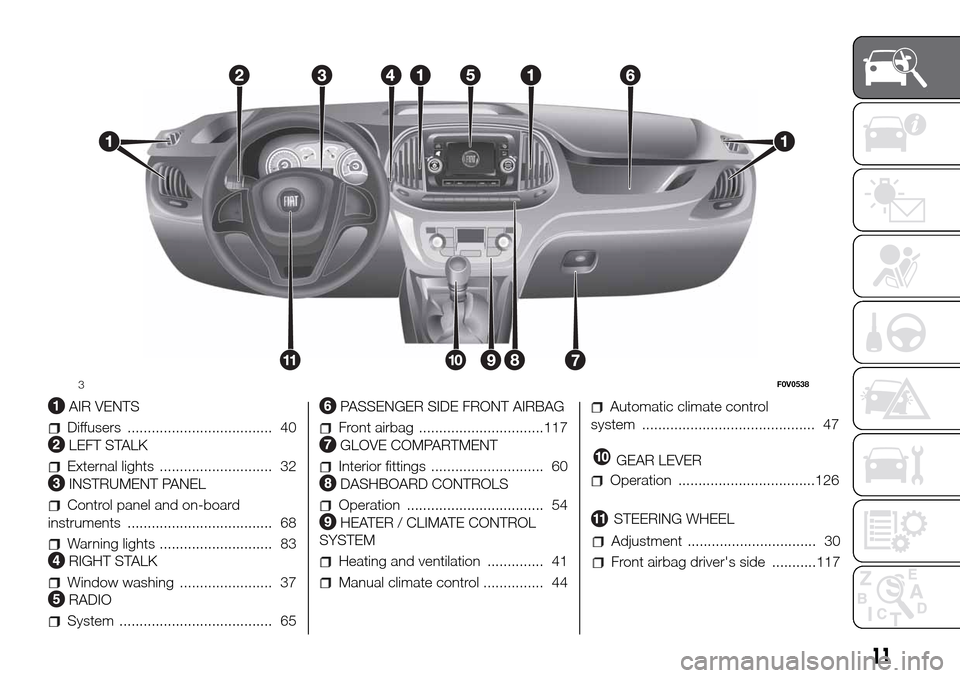
.
AIR VENTS
Diffusers .................................... 40
LEFT STALK
External lights ............................ 32
INSTRUMENT PANEL
Control panel and on-board
instruments .................................... 68
Warning lights ............................ 83
RIGHT STALK
Window washing ....................... 37
RADIO
System ...................................... 65
PASSENGER SIDE FRONT AIRBAG
Front airbag ...............................117
GLOVE COMPARTMENT
Interior fittings ............................ 60
DASHBOARD CONTROLS
Operation .................................. 54
HEATER / CLIMATE CONTROL
SYSTEM
Heating and ventilation .............. 41
Manual climate control ............... 44
Automatic climate control
system ........................................... 47
GEAR LEVER
Operation ..................................126
STEERING WHEEL
Adjustment ................................ 30
Front airbag driver's side ...........117
3F0V0538
11
Page 27 of 298
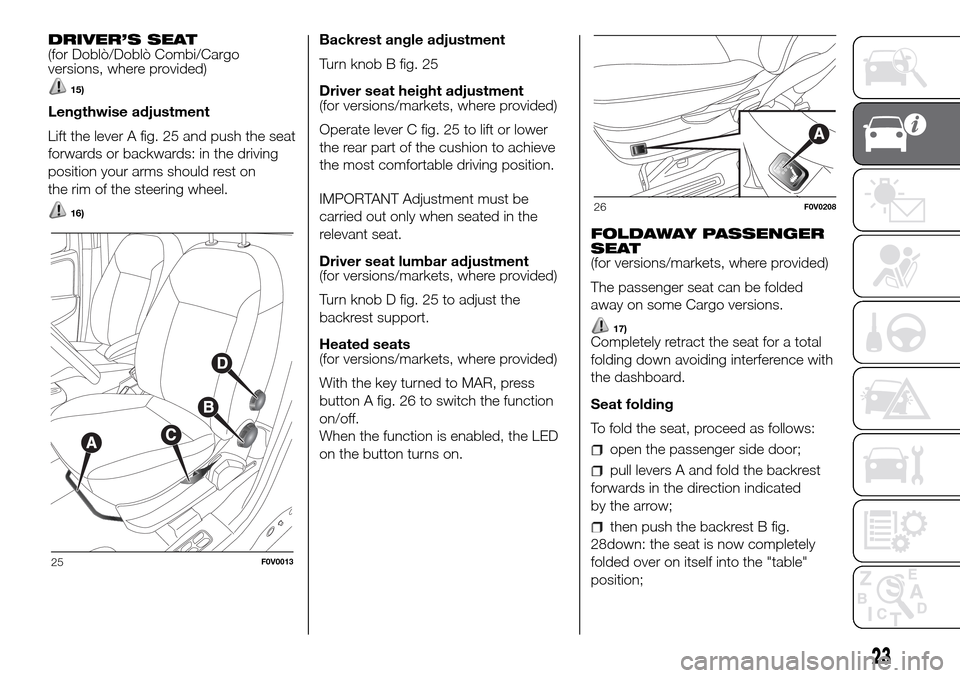
DRIVER’S SEAT
(for Doblò/Doblò Combi/Cargo
versions, where provided)
15)
Lengthwise adjustment
Lift the lever A fig. 25 and push the seat
forwards or backwards: in the driving
position your arms should rest on
the rim of the steering wheel.
16)
Backrest angle adjustment
Turn knob B fig. 25
Driver seat height adjustment
(for versions/markets, where provided)
Operate lever C fig. 25 to lift or lower
the rear part of the cushion to achieve
the most comfortable driving position.
IMPORTANT Adjustment must be
carried out only when seated in the
relevant seat.
Driver seat lumbar adjustment
(for versions/markets, where provided)
Turn knob D fig. 25 to adjust the
backrest support.
Heated seats
(for versions/markets, where provided)
With the key turned to MAR, press
button A fig. 26 to switch the function
on/off.
When the function is enabled, the LED
on the button turns on.FOLDAWAY PASSENGER
SEAT
(for versions/markets, where provided)
The passenger seat can be folded
away on some Cargo versions.
17)Completely retract the seat for a total
folding down avoiding interference with
the dashboard.
Seat folding
To fold the seat, proceed as follows:
open the passenger side door;
pull levers A and fold the backrest
forwards in the direction indicated
by the arrow;
then push the backrest B fig.
28down: the seat is now completely
folded over on itself into the "table"
position;
25F0V0013
26F0V0208
23
Page 28 of 298
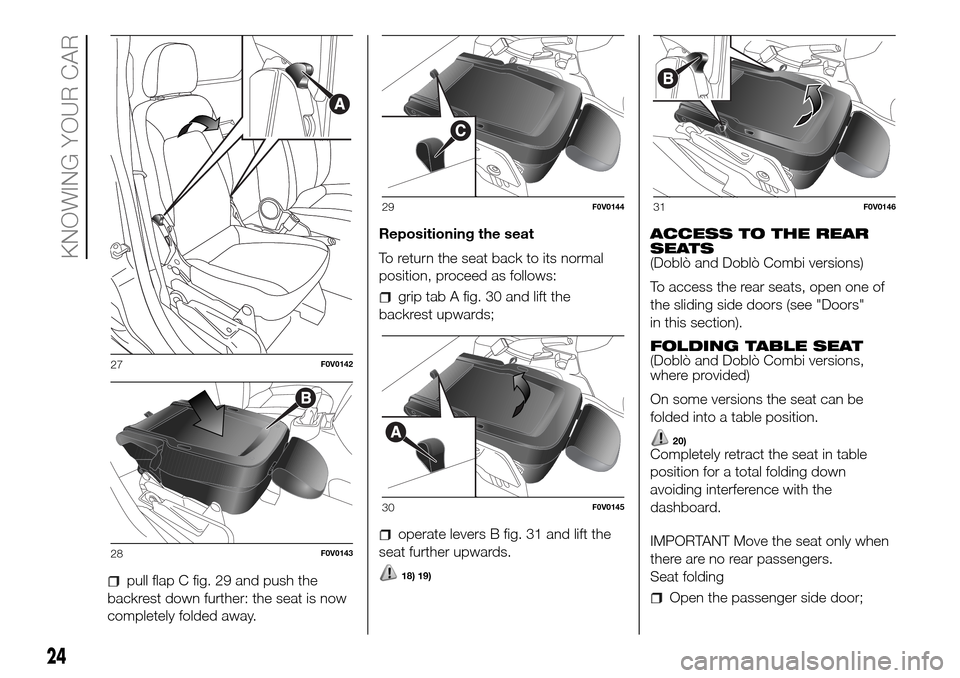
pull flap C fig. 29 and push the
backrest down further: the seat is now
completely folded away.Repositioning the seat
To return the seat back to its normal
position, proceed as follows:
grip tab A fig. 30 and lift the
backrest upwards;
operate levers B fig. 31 and lift the
seat further upwards.
18) 19)
ACCESS TO THE REAR
SEATS
(Doblò and Doblò Combi versions)
To access the rear seats, open one of
the sliding side doors (see "Doors"
in this section).
FOLDING TABLE SEAT
(Doblò and Doblò Combi versions,
where provided)
On some versions the seat can be
folded into a table position.
20)Completely retract the seat in table
position for a total folding down
avoiding interference with the
dashboard.
IMPORTANT Move the seat only when
there are no rear passengers.
Seat folding
Open the passenger side door;
27F0V0142
28F0V0143
29F0V0144
30F0V0145
31F0V0146
24
KNOWING YOUR CAR
Page 31 of 298

WARNING
15)All adjustments must be made with the
vehicle stationary.
16)After releasing the adjustment lever,
always check that the seat is locked on the
guides by trying to move it back and forth.
If it is not locked, the seat may move
unexpectedly and make you lose control of
the vehicle.
17)Close the dashboard console before
folding the retractable front passenger seat
to avoid damage.
18)When the passenger seat is folded
away, the space created cannot be used
for loading. When the vehicle is in motion,
you are therefore advised to remove or
secure any objects that might interfere with
the driver.
19)If there is no partition between the cab
and the load compartment, tall objects
or packages may take up part of the
passenger area. Make sure that these
items are well secured by using the
available hooks and that they cannot
interfere with the driver.
20)Close the dashboard console before
folding the front passenger seat into table
position to avoid damage.
21)While travelling, before using the third
row seats, make sure that the second
row seats are in driving position and
correctly secured (see dedicated plate fig.
34.
PARTITIONS
FIXED PANEL PARTITION
(for versions/markets, where provided)
Separates the passenger area from
the load compartment fig. 40.
For versions fitted with 3-seater front
bench seat, the guard has the retractor
for the central rear seat belt fig. 41FIXED GLAZED
PARTITION
(for versions/markets, where provided)
This has a central window so you
can keep an eye on your load fig. 42.
For versions fitted with 3-seater front
bench seat, the guard has the retractor
for the central rear seat belt fig. 41
SPLIT ROTATING
PARTITION
(for versions/markets, where provided)
Should it be necessary to transport
long, bulky loads, the passenger side
panel can be removed and fixed to the
driver’s side, as follows fig. 43:
lay the foldaway passenger seat flat
(see previous pages);
40F0V0102
41F0V0620
42F0V0103
27
Page 36 of 298
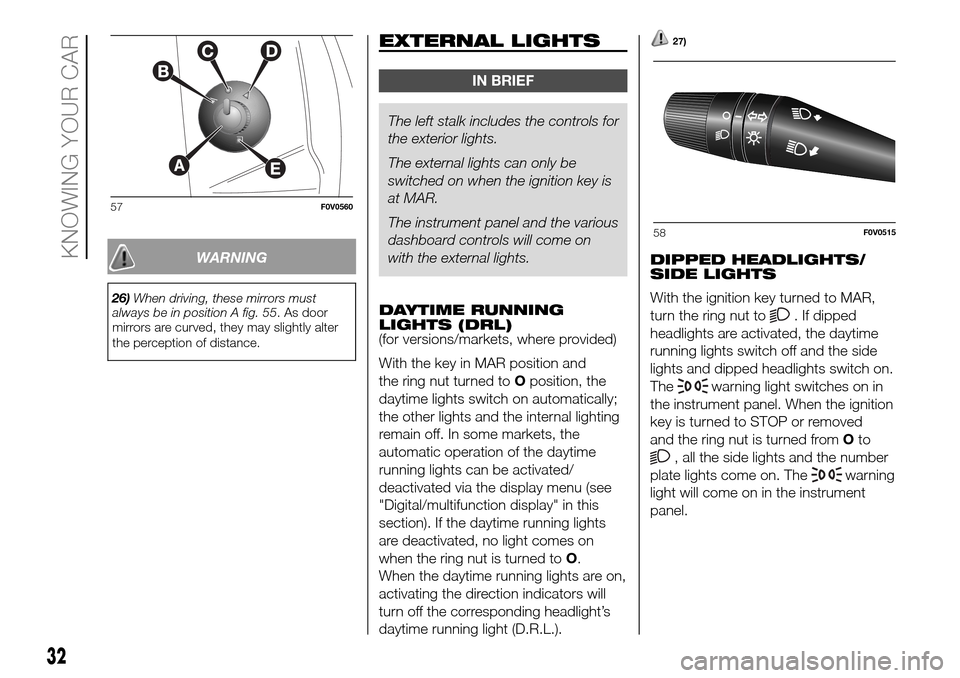
WARNING
26)When driving, these mirrors must
always be in position A fig. 55. As door
mirrors are curved, they may slightly alter
the perception of distance.
EXTERNAL LIGHTS
IN BRIEF
The left stalk includes the controls for
the exterior lights.
The external lights can only be
switched on when the ignition key is
at MAR.
The instrument panel and the various
dashboard controls will come on
with the external lights.
DAYTIME RUNNING
LIGHTS (DRL)
(for versions/markets, where provided)
With the key in MAR position and
the ring nut turned toOposition, the
daytime lights switch on automatically;
the other lights and the internal lighting
remain off. In some markets, the
automatic operation of the daytime
running lights can be activated/
deactivated via the display menu (see
"Digital/multifunction display" in this
section). If the daytime running lights
are deactivated, no light comes on
when the ring nut is turned toO.
When the daytime running lights are on,
activating the direction indicators will
turn off the corresponding headlight’s
daytime running light (D.R.L.).
27)
DIPPED HEADLIGHTS/
SIDE LIGHTS
With the ignition key turned to MAR,
turn the ring nut to
. If dipped
headlights are activated, the daytime
running lights switch off and the side
lights and dipped headlights switch on.
The
warning light switches on in
the instrument panel. When the ignition
key is turned to STOP or removed
and the ring nut is turned fromOto
, all the side lights and the number
plate lights come on. The
warning
light will come on in the instrument
panel.
57F0V0560
58F0V0515
32
KNOWING YOUR CAR
Page 37 of 298
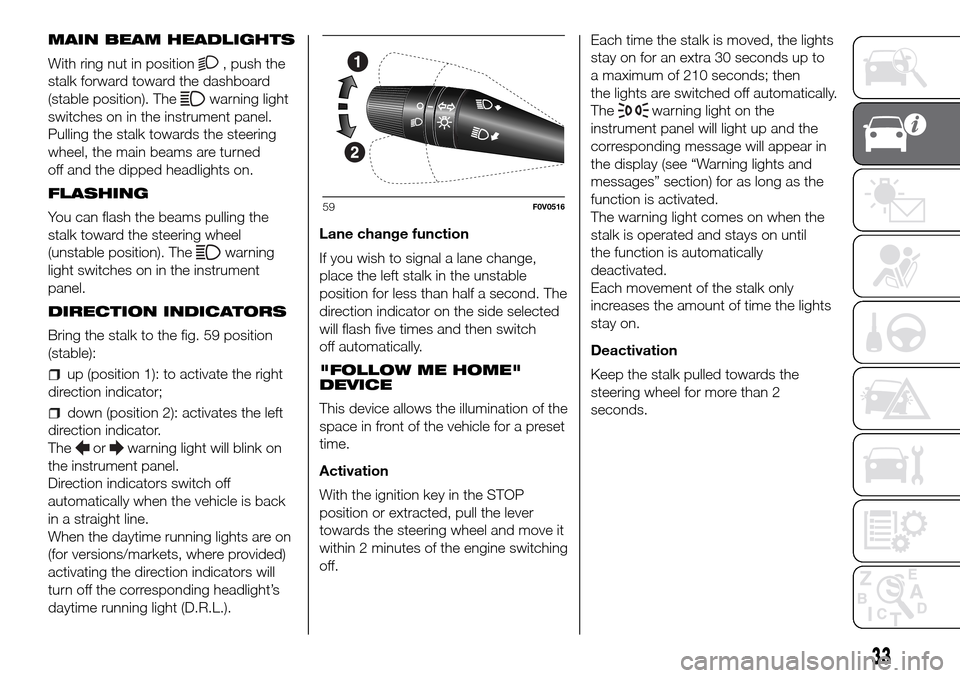
MAIN BEAM HEADLIGHTS
With ring nut in position
, push the
stalk forward toward the dashboard
(stable position). The
warning light
switches on in the instrument panel.
Pulling the stalk towards the steering
wheel, the main beams are turned
off and the dipped headlights on.
FLASHING
You can flash the beams pulling the
stalk toward the steering wheel
(unstable position). The
warning
light switches on in the instrument
panel.
DIRECTION INDICATORS
Bring the stalk to the fig. 59 position
(stable):
up (position 1): to activate the right
direction indicator;
down (position 2): activates the left
direction indicator.
The
orwarning light will blink on
the instrument panel.
Direction indicators switch off
automatically when the vehicle is back
in a straight line.
When the daytime running lights are on
(for versions/markets, where provided)
activating the direction indicators will
turn off the corresponding headlight’s
daytime running light (D.R.L.).Lane change function
If you wish to signal a lane change,
place the left stalk in the unstable
position for less than half a second. The
direction indicator on the side selected
will flash five times and then switch
off automatically.
"FOLLOW ME HOME"
DEVICE
This device allows the illumination of the
space in front of the vehicle for a preset
time.
Activation
With the ignition key in the STOP
position or extracted, pull the lever
towards the steering wheel and move it
within 2 minutes of the engine switching
off.Each time the stalk is moved, the lights
stay on for an extra 30 seconds up to
a maximum of 210 seconds; then
the lights are switched off automatically.
The
warning light on the
instrument panel will light up and the
corresponding message will appear in
the display (see “Warning lights and
messages” section) for as long as the
function is activated.
The warning light comes on when the
stalk is operated and stays on until
the function is automatically
deactivated.
Each movement of the stalk only
increases the amount of time the lights
stay on.
Deactivation
Keep the stalk pulled towards the
steering wheel for more than 2
seconds.
59F0V0516
33
Page 42 of 298
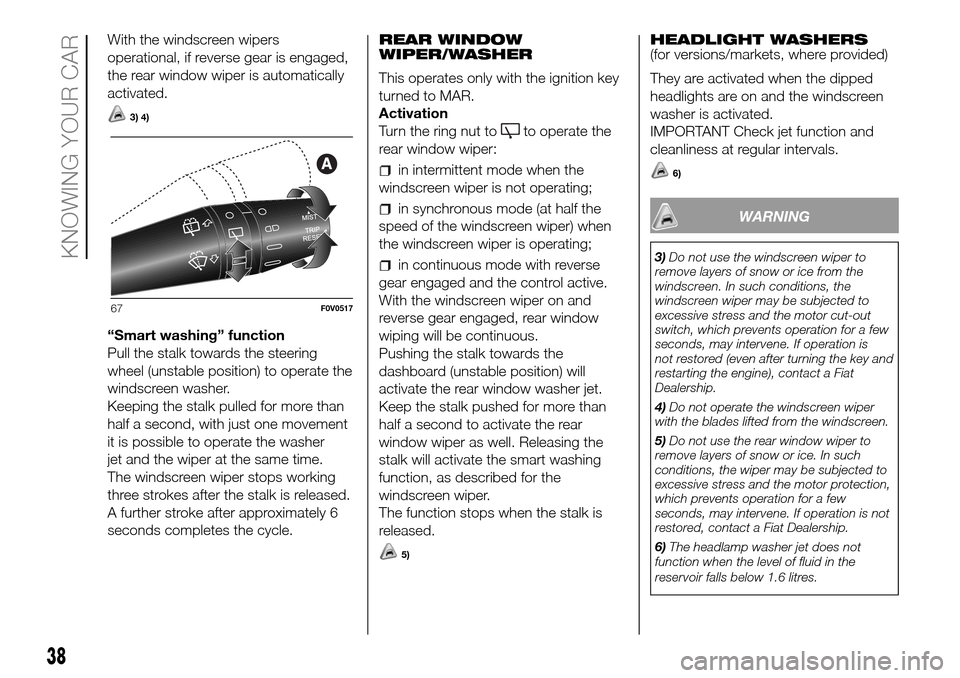
With the windscreen wipers
operational, if reverse gear is engaged,
the rear window wiper is automatically
activated.
3) 4)
“Smart washing” function
Pull the stalk towards the steering
wheel (unstable position) to operate the
windscreen washer.
Keeping the stalk pulled for more than
half a second, with just one movement
it is possible to operate the washer
jet and the wiper at the same time.
The windscreen wiper stops working
three strokes after the stalk is released.
A further stroke after approximately 6
seconds completes the cycle.REAR WINDOW
WIPER/WASHER
This operates only with the ignition key
turned to MAR.
Activation
Turn the ring nut to
to operate the
rear window wiper:
in intermittent mode when the
windscreen wiper is not operating;
in synchronous mode (at half the
speed of the windscreen wiper) when
the windscreen wiper is operating;
in continuous mode with reverse
gear engaged and the control active.
With the windscreen wiper on and
reverse gear engaged, rear window
wiping will be continuous.
Pushing the stalk towards the
dashboard (unstable position) will
activate the rear window washer jet.
Keep the stalk pushed for more than
half a second to activate the rear
window wiper as well. Releasing the
stalk will activate the smart washing
function, as described for the
windscreen wiper.
The function stops when the stalk is
released.
5)
HEADLIGHT WASHERS
(for versions/markets, where provided)
They are activated when the dipped
headlights are on and the windscreen
washer is activated.
IMPORTANT Check jet function and
cleanliness at regular intervals.
6)
WARNING
3)Do not use the windscreen wiper to
remove layers of snow or ice from the
windscreen. In such conditions, the
windscreen wiper may be subjected to
excessive stress and the motor cut-out
switch, which prevents operation for a few
seconds, may intervene. If operation is
not restored (even after turning the key and
restarting the engine), contact a Fiat
Dealership.
4)Do not operate the windscreen wiper
with the blades lifted from the windscreen.
5)Do not use the rear window wiper to
remove layers of snow or ice. In such
conditions, the wiper may be subjected to
excessive stress and the motor protection,
which prevents operation for a few
seconds, may intervene. If operation is not
restored, contact a Fiat Dealership.
6)The headlamp washer jet does not
function when the level of fluid in the
reservoir falls below 1.6 litres.
67F0V0517
38
KNOWING YOUR CAR
Page 46 of 298
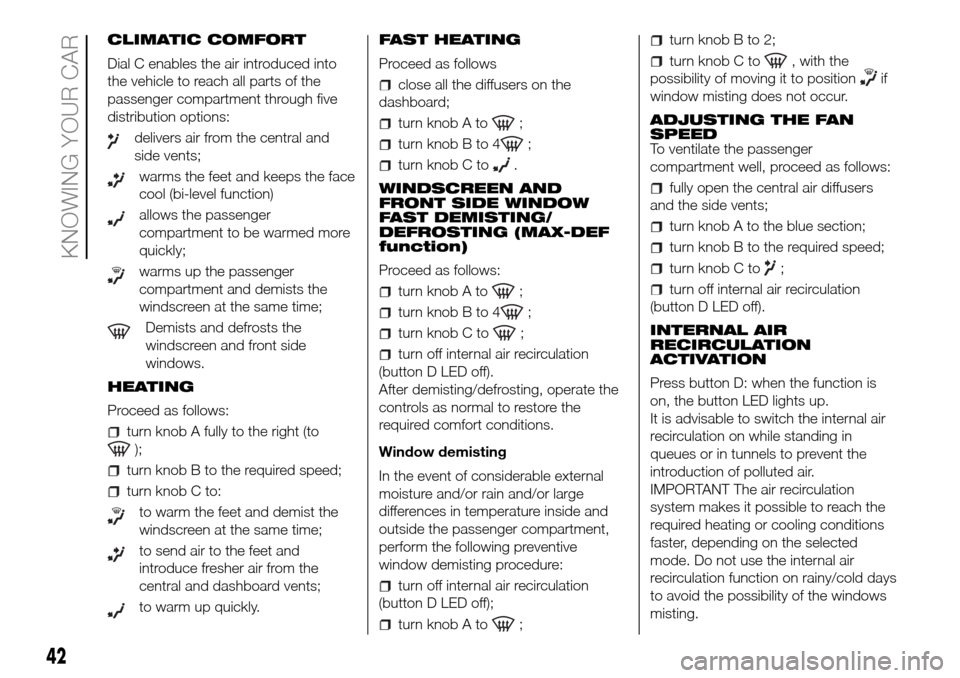
CLIMATIC COMFORT
Dial C enables the air introduced into
the vehicle to reach all parts of the
passenger compartment through five
distribution options:
delivers air from the central and
side vents;
warms the feet and keeps the face
cool (bi-level function)
allows the passenger
compartment to be warmed more
quickly;
warms up the passenger
compartment and demists the
windscreen at the same time;
Demists and defrosts the
windscreen and front side
windows.
HEATING
Proceed as follows:
turn knob A fully to the right (to
);
turn knob B to the required speed;
turn knob C to:
to warm the feet and demist the
windscreen at the same time;
to send air to the feet and
introduce fresher air from the
central and dashboard vents;
to warm up quickly.FAST HEATING
Proceed as follows
close all the diffusers on the
dashboard;
turn knob A to;
turn knob B to 4;
turn knob C to.
WINDSCREEN AND
FRONT SIDE WINDOW
FAST DEMISTING/
DEFROSTING (MAX-DEF
function)
Proceed as follows:
turn knob A to;
turn knob B to 4;
turn knob C to;
turn off internal air recirculation
(button D LED off).
After demisting/defrosting, operate the
controls as normal to restore the
required comfort conditions.
Window demisting
In the event of considerable external
moisture and/or rain and/or large
differences in temperature inside and
outside the passenger compartment,
perform the following preventive
window demisting procedure:
turn off internal air recirculation
(button D LED off);
turn knob A to;
turn knob B to 2;
turn knob C to, with the
possibility of moving it to position
if
window misting does not occur.
ADJUSTING THE FAN
SPEED
To ventilate the passenger
compartment well, proceed as follows:
fully open the central air diffusers
and the side vents;
turn knob A to the blue section;
turn knob B to the required speed;
turn knob C to;
turn off internal air recirculation
(button D LED off).
INTERNAL AIR
RECIRCULATION
ACTIVATION
Press button D: when the function is
on, the button LED lights up.
It is advisable to switch the internal air
recirculation on while standing in
queues or in tunnels to prevent the
introduction of polluted air.
IMPORTANT The air recirculation
system makes it possible to reach the
required heating or cooling conditions
faster, depending on the selected
mode. Do not use the internal air
recirculation function on rainy/cold days
to avoid the possibility of the windows
misting.
42
KNOWING YOUR CAR
Page 53 of 298
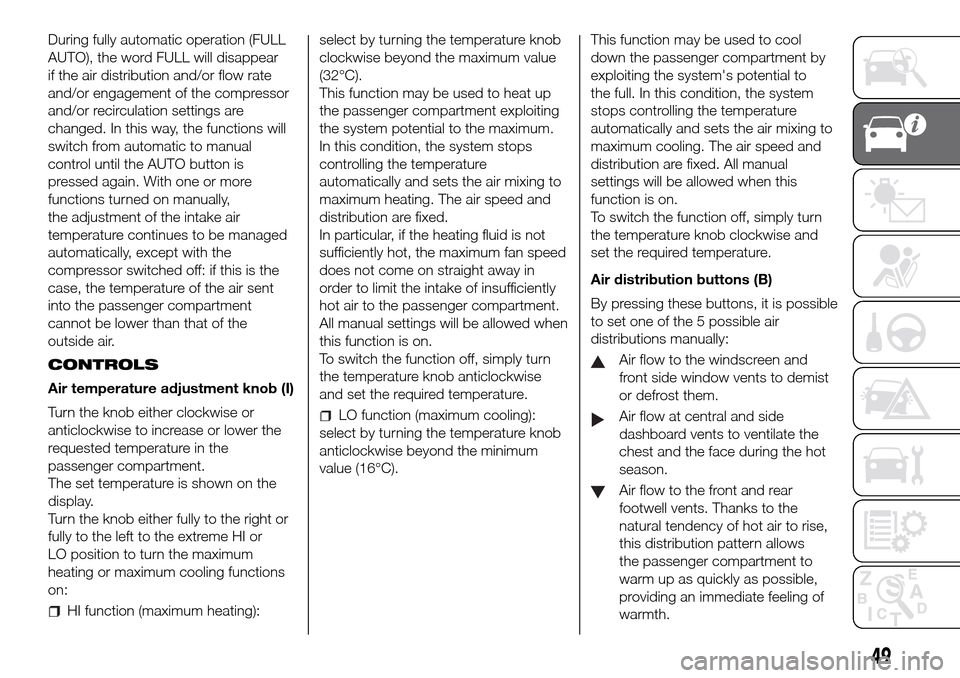
During fully automatic operation (FULL
AUTO), the word FULL will disappear
if the air distribution and/or flow rate
and/or engagement of the compressor
and/or recirculation settings are
changed. In this way, the functions will
switch from automatic to manual
control until the AUTO button is
pressed again. With one or more
functions turned on manually,
the adjustment of the intake air
temperature continues to be managed
automatically, except with the
compressor switched off: if this is the
case, the temperature of the air sent
into the passenger compartment
cannot be lower than that of the
outside air.
CONTROLS
Air temperature adjustment knob (I)
Turn the knob either clockwise or
anticlockwise to increase or lower the
requested temperature in the
passenger compartment.
The set temperature is shown on the
display.
Turn the knob either fully to the right or
fully to the left to the extreme HI or
LO position to turn the maximum
heating or maximum cooling functions
on:
HI function (maximum heating):select by turning the temperature knob
clockwise beyond the maximum value
(32°C).
This function may be used to heat up
the passenger compartment exploiting
the system potential to the maximum.
In this condition, the system stops
controlling the temperature
automatically and sets the air mixing to
maximum heating. The air speed and
distribution are fixed.
In particular, if the heating fluid is not
sufficiently hot, the maximum fan speed
does not come on straight away in
order to limit the intake of insufficiently
hot air to the passenger compartment.
All manual settings will be allowed when
this function is on.
To switch the function off, simply turn
the temperature knob anticlockwise
and set the required temperature.
LO function (maximum cooling):
select by turning the temperature knob
anticlockwise beyond the minimum
value (16°C).This function may be used to cool
down the passenger compartment by
exploiting the system's potential to
the full. In this condition, the system
stops controlling the temperature
automatically and sets the air mixing to
maximum cooling. The air speed and
distribution are fixed. All manual
settings will be allowed when this
function is on.
To switch the function off, simply turn
the temperature knob clockwise and
set the required temperature.
Air distribution buttons (B)
By pressing these buttons, it is possible
to set one of the 5 possible air
distributions manually:
Air flow to the windscreen and
front side window vents to demist
or defrost them.
Air flow at central and side
dashboard vents to ventilate the
chest and the face during the hot
season.
Air flow to the front and rear
footwell vents. Thanks to the
natural tendency of hot air to rise,
this distribution pattern allows
the passenger compartment to
warm up as quickly as possible,
providing an immediate feeling of
warmth.
49
Page 54 of 298
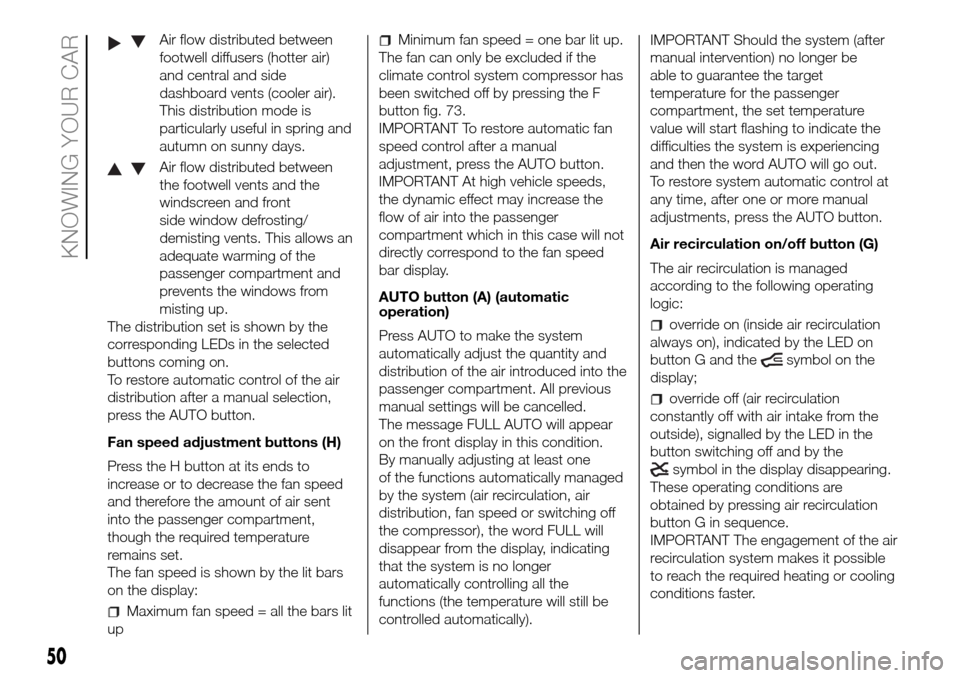
Air flow distributed between
footwell diffusers (hotter air)
and central and side
dashboard vents (cooler air).
This distribution mode is
particularly useful in spring and
autumn on sunny days.
Air flow distributed between
the footwell vents and the
windscreen and front
side window defrosting/
demisting vents. This allows an
adequate warming of the
passenger compartment and
prevents the windows from
misting up.
The distribution set is shown by the
corresponding LEDs in the selected
buttons coming on.
To restore automatic control of the air
distribution after a manual selection,
press the AUTO button.
Fan speed adjustment buttons (H)
Press the H button at its ends to
increase or to decrease the fan speed
and therefore the amount of air sent
into the passenger compartment,
though the required temperature
remains set.
The fan speed is shown by the lit bars
on the display:
Maximum fan speed = all the bars lit
up
Minimum fan speed = one bar lit up.
The fan can only be excluded if the
climate control system compressor has
been switched off by pressing the F
button fig. 73.
IMPORTANT To restore automatic fan
speed control after a manual
adjustment, press the AUTO button.
IMPORTANT At high vehicle speeds,
the dynamic effect may increase the
flow of air into the passenger
compartment which in this case will not
directly correspond to the fan speed
bar display.
AUTO button (A) (automatic
operation)
Press AUTO to make the system
automatically adjust the quantity and
distribution of the air introduced into the
passenger compartment. All previous
manual settings will be cancelled.
The message FULL AUTO will appear
on the front display in this condition.
By manually adjusting at least one
of the functions automatically managed
by the system (air recirculation, air
distribution, fan speed or switching off
the compressor), the word FULL will
disappear from the display, indicating
that the system is no longer
automatically controlling all the
functions (the temperature will still be
controlled automatically).IMPORTANT Should the system (after
manual intervention) no longer be
able to guarantee the target
temperature for the passenger
compartment, the set temperature
value will start flashing to indicate the
difficulties the system is experiencing
and then the word AUTO will go out.
To restore system automatic control at
any time, after one or more manual
adjustments, press the AUTO button.
Air recirculation on/off button (G)
The air recirculation is managed
according to the following operating
logic:
override on (inside air recirculation
always on), indicated by the LED on
button G and the
symbol on the
display;
override off (air recirculation
constantly off with air intake from the
outside), signalled by the LED in the
button switching off and by the
symbol in the display disappearing.
These operating conditions are
obtained by pressing air recirculation
button G in sequence.
IMPORTANT The engagement of the air
recirculation system makes it possible
to reach the required heating or cooling
conditions faster.
50
KNOWING YOUR CAR